- Army
- Air Defense Systems
- Anti-tank systems and vehicles
- Armored Vehicles
- Armoured personnel carriers
- Artillery Vehicles and Weapons
- Command Post
- Communication Vehicles and Systems
- Electronic Warfare
- Engineer | Maintenance Vehicles
- Infantry Fighting Vehicles
- Main Battle Tanks
- Missiles
- Tactical and Logistic Vehicles
- Radars
- Unmanned Systems
- Weapons
- Navy
- Air
S-300P SA-10 Grumble
S-300P SA-10 Grumble
Long-range air defense missile system - Russia

Description
The S-300-P, NATO designation SA-10 Grumble is the first variant of the Russian-made S-300 family of long-range surface-to-air missile systems. The S-300P was designed and manufactured by the Company Almaz Antey. The S-300 system was developed to defeat aircraft and cruise missiles. The design aims of the original S-300P were to produce a strategic area defense SAM system, intended to protect fixed targets such as government precincts, industrial facilities, command posts and headquarters, military bases, strategic and tactical airfields, and nuclear sites. Subsequent variations were developed to intercept ballistic missiles. The S-300 enters in service with the Russian army in 1979. Russia has exported different variants of the S-300P system to at least 14 countries including Algeria, Armenia, Azerbaijan, Belarus, Bulgaria, China, Croatia, Cyprus, Greece, Hungary, Kazakhstan, Slovakia, Ukraine, and Vietnam but the S-300P is no longer produced.
SA-10 Grumble S-300P variants:
- S-300 F: naval version of the S-300
- S-300V: four missiles mounted to a tracked vehicle.
- S-300 PS: Four missiles mounted to a Maz-543 truck.
- S-300 PM: Four missiles mounted to a Kraz-260 truck.
- S-300 PM1: upgraded version of S-300 PM, new missile, and association with a new radar system
- S-300 PM2: upgraded version of S-300 PM1, with a higher range.
- S-300 PMU: export version of S-300 PS/PM
- S-300 PMU1: export version of S-300 PM1
- S-300 PMU2: export version of S-300 PM2
Technical Data
| Missile launcher unit |
|
The S-300P is based on a trailer that carries four missile silos (one missile by silo) mounted to the backside of the trailer. The four launch tubes were mounted on a hydraulically elevated frame. During launching the silos are drawn in the vertical position, to the backside of the trailer. In firing position, a forward boom splayed is deployed as stabilizers. The weapon was gas-ejected from its container launcher to a height of 25 m before the rocket motor fired. Emplacement time was stated to be over 30 minutes.
|
| Missile |
|
The S-300P can fire the first generation of V-500/5V55K missile which uses a single-stage solid rocket motor. The missile was deployed and handled in a sealed cylindrical launch tube/canister, with a cold start gas generator used to eject the missile vertically before its motor was initiated. This was the first Russian missile to incorporate a significant level of solid-state electronics in its guidance system. The maximum effective engagement range of the 5V55K missile was 47 km and could engage its targets between 100 and 30,000 m.
|
| Truck tractor |
| The S-300P trailer is towed by a MAZ-543 8x8 or a KRAZ 6x6 truck. The TEL (Transporter Erector Launcher) truck is named 5P85. The MAZ-543 is motorized with a D12A-525 V-12 water-cooled diesel developing 525 hp at 2,100 rpm. It has a total weight of 42,150 kg and can run at a maximum speed of 60 km/h with a maximum road range of 650 km. |
| Command and Control vehicles |
| An S-300P battery configuration consists of three semi-trailer launchers and a single 5N63 radar. The battery could simultaneously engage up to a maximum of six targets with 12 missiles under command guidance. The S-300P uses the 5N63 (later 30N6) (NATO Code Flap Lid) engagement/fire control radar. The Flap Lid's antenna stows flat on the roof of the radar cabin, which was initially deployed on a trailer towed by a Ural-357, KrAZ-255, or KrAZ-260 6x6 tractor. The whole radar cabin is mounted on a turntable and used to slew the phased array to cover a 60-degree sector of interest. The radar is able to track up to six targets simultaneously. At regimental and brigade level the 36D6 (NATO codename `Tin Shield') 3-D S-band surveillance radar was used. This was available in two versions, the basic system mounted on a semi-trailer truck and the enhanced low altitude capability 40V6M1 tower assembly built specifically for use with the S-300P family. |
| 5N63 Engagement control radar |
 The S-300P uses the 5N63 (later 30N6) (NATO Code Flap Lid) engagement/fire control radar. |
| 36D6 S-Band surveillance radar |
 At regimental and brigade level the 36D6 (NATO codename `Tin Shield') 3-D S-band surveillance radar was used. |
Specifications
| Type | Missile Weight |
| Long-range surface-to-air defense missile system | 1,640 kg |
| Armament | Missile length |
| Four missiles 5V55K stored in an individual container | 7.25 m |
| Country users | Missile Range |
| Russia, Azerbaijan, Belarus, China, Croatia, Syria | 47 km |
| Missile warhead | Guidance System |
| High explosive ; fragmentation | Radio control |
| Warhead weight | Radars |
| 133 kg | Engagement radar 5N63 Flap Lid engagement radar and 36D6 3-D S-band surveillance radar. |
Details View
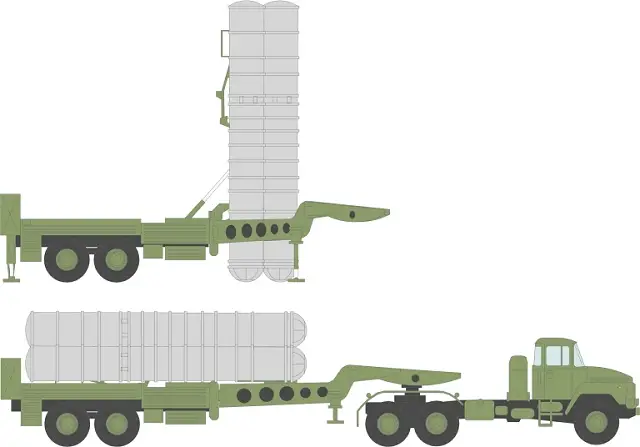 |
|
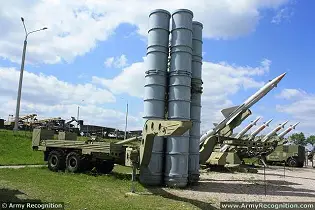 |
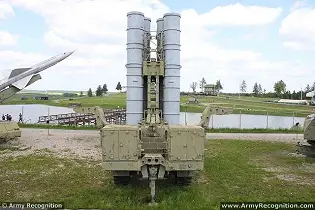 |
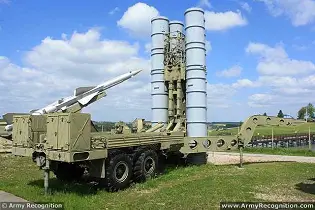 |
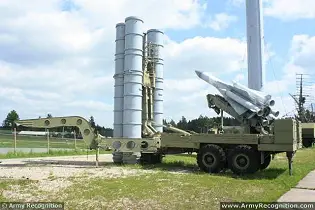 |
Pictures - Video



























